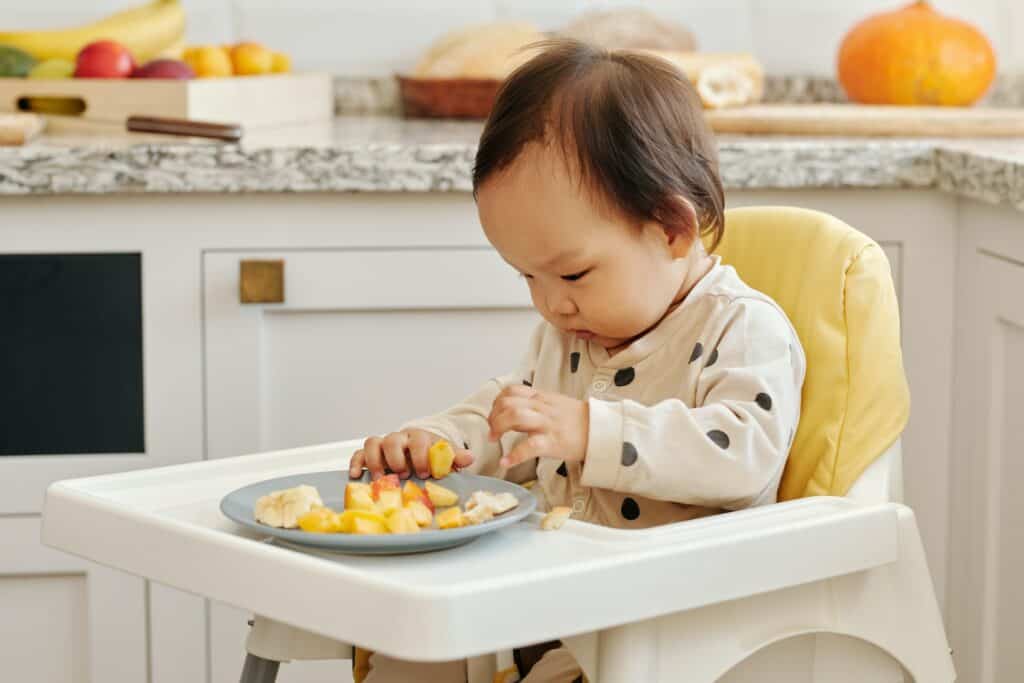Parents who are eager to introduce their little ones to solid foods are often curious about when they can start using a high chair. A high chair is a great tool for feeding babies, as it provides a safe and comfortable space for them to sit and eat. However, parents should be aware of the appropriate age to introduce a high chair to their babies.
Understanding when can baby sit in high chair is important for both the baby’s safety and comfort. While some babies may be ready to use a high chair as early as four months old, others may not be ready until they are six months or older. Parents should also consider their baby’s developmental milestones, such as being able to sit up unsupported and having good head and neck control, before introducing a high chair.
Key Takeaways
- Introducing a high chair to a baby should be done when the baby is developmentally ready, which can vary from baby to baby.
- Safety and comfort are important considerations when choosing when to introduce a high chair.
- Parents should consider their baby’s developmental milestones, such as sitting up unsupported and having good head and neck control, before introducing a high chair.
Understanding High Chairs
High chairs are a popular choice for parents to feed their babies. They provide a safe and comfortable place for babies to sit while eating. High chairs are designed to be adjustable in size, stability, and foldability to meet the needs of both the baby and the parents.
Types of High Chairs
There are several types of high chairs available in the market. Some of the most common types include:
- Traditional High Chairs: These high chairs are designed to be used from six months to three years of age. They have a padded seat and a removable tray for easy cleaning.
- Booster Seats: Booster seats are designed to be used on a regular chair. They are perfect for older babies who can sit up on their own and just need a little extra height to reach the table.
- Convertible High Chairs: These high chairs can be converted into a toddler chair or a regular chair. They are perfect for parents who want to save money and space.
Choosing the Right High Chair
When choosing a high chair, parents should consider the following factors:
- Durability: The high chair should be durable enough to last for several years.
- Safety: The high chair should be stable and secure to prevent the baby from falling.
- Adjustability: The high chair should be adjustable in height and seat position to accommodate the growing baby.
- Foldability: If space is a concern, parents should choose a high chair that is easy to fold and store.
- Catch: A high chair with a catch tray can help prevent food from falling onto the baby’s lap.
- Padded Seat: A padded seat can provide extra comfort for the baby.
- Removable Tray: A removable tray can make cleaning the high chair easier.
It is important to choose a high chair that meets the safety standards set by the Juvenile Products Manufacturers Association (JPMA). Parents should also consider the material of the high chair. Wooden high chairs are durable and stylish, while plastic high chairs are lightweight and easy to clean.
In conclusion, high chairs are an important investment for parents. By considering the factors mentioned above, parents can choose the right high chair for their baby.
When to Introduce a High Chair

Baby’s Developmental Milestones
Introducing a high chair to your baby’s feeding routine is an exciting transition. However, it is important to ensure that your baby is developmentally ready for this change. One of the key milestones to look out for is when your baby can sit independently. This means that they can sit up without any support and maintain their balance. Typically, babies reach this milestone around four to six months of age.
Before introducing a high chair, it is also important to ensure that your baby has had enough tummy time. This helps to strengthen their neck and back muscles, which are crucial for sitting up independently. It is recommended that babies have at least 30-60 minutes of tummy time each day.
Introducing Solid Foods
Another important factor to consider when introducing a high chair is your baby’s readiness to start solid foods. Most babies are ready for solid foods around six months of age. However, it is important to consult with your pediatrician to determine if your baby is ready.
When introducing solid foods, it is recommended to start with simple purees and gradually introduce more complex textures. This allows your baby to get used to the new flavors and textures and reduces the risk of choking.
When transitioning to a high chair, it is important to ensure that your baby is securely strapped in and that the chair is stable and safe. Always supervise your baby during meal times and never leave them unattended.
In summary, introducing a high chair is an exciting milestone for both you and your baby. However, it is important to ensure that your baby is developmentally ready and that you follow safe feeding practices.
Safety Considerations
When it comes to choosing a high chair for your baby, safety should be your top priority. Here are some safety considerations to keep in mind:

1. Harness and Safety Straps
One of the most important safety features of a high chair is the harness or safety straps. A 5-point harness is the safest option as it secures the baby at the waist, shoulders, and between the legs. Make sure the harness is adjustable and fits snugly around the baby. A crotch post can also provide additional support and prevent the baby from sliding out of the chair.
2. High Chair Stability
A stable high chair is essential to prevent it from tipping over. Look for a chair with a wide base and lockable wheels. The wheels can be useful for moving the chair around, but they should be locked in place when the baby is seated. Check the weight limit of the chair and make sure it can support the weight of your baby.
3. Safety Recalls
Check for safety recalls before purchasing a high chair. A recalled chair may have safety issues that could put your baby at risk. You can check for recalls on the manufacturer’s website or on the Consumer Product Safety Commission’s website.
By keeping these safety considerations in mind, you can ensure that your baby sits in a high chair that is safe and secure.
Also, read: When to Use Bumbo Seat
Proper Positioning in a High Chair
Adjusting the Seat Height
When using a high chair, it is important to adjust the seat height so that the baby’s feet can rest flat on the floor. This helps to promote good posture and stability. If the seat is too high, the baby may be forced to lean forward, which can cause them to lose their balance and fall out of the chair.
Most high chairs come with adjustable seat heights, so it is important to make sure that the seat is set at the appropriate height for the baby’s size. A good rule of thumb is to adjust the seat so that the baby’s knees are at a 90-degree angle and their feet are flat on the floor.
Ensuring Correct Posture
Proper posture is important for babies when sitting in a high chair. It helps to promote good spine and neck health and can prevent discomfort and injury. When placing the baby in the chair, make sure that their back is straight and their head is upright.
It is also important to make sure that the baby is not leaning to one side or the other. This can cause discomfort and can also make it difficult for the baby to maintain their balance.
In addition, it is important to make sure that the baby has good neck control. If the baby’s head is not stable, it can cause them to slouch or lean forward, which can lead to discomfort and injury.
Overall, when using a high chair, it is important to make sure that the baby is sitting upright and in a comfortable and stable position. This can help to promote good posture and prevent discomfort and injury.
Feeding in a High Chair

In summary, feeding a baby in a high chair is a great way to introduce solid foods and encourage self-feeding. Using the tray and transitioning to self-feeding are important steps in this process. By following these tips and guidelines, parents can help their babies develop healthy eating habits and enjoy mealtime together.
Using the Tray
When a baby is ready to sit in a high chair, they are usually ready to start eating solid foods. High chairs usually come with a tray that snaps onto the front of the chair and provides a surface for the baby to eat from. The tray should be securely attached to the chair and should be at a comfortable height for the baby to reach. It is important to make sure the tray is clean and free from any debris before placing food on it.
When feeding a baby in a high chair, it is important to make sure they are sitting up straight and not slouching. This will help prevent choking and make it easier for the baby to swallow. The baby should be facing forward and not turned to the side or facing backwards.
Transitioning to Self-Feeding
As the baby grows and develops, they will eventually start to show an interest in self-feeding. This is a great time to start introducing finger foods and utensils. It is important to supervise the baby closely during this time to make sure they are not choking or having difficulty swallowing.
When transitioning to self-feeding, it is important to provide the baby with a variety of foods and textures. This will help them develop their taste buds and encourage them to try new things. Soft fruits and vegetables, such as bananas and cooked carrots, are great options for babies who are just starting to self-feed.
Additional Features and Considerations
When purchasing a high chair for your baby, there are several additional features and considerations to keep in mind beyond the basic functions of the chair. These features can affect the usability, safety, and convenience of the high chair for both you and your baby.
1. Space and Lifestyle Considerations
When choosing a high chair, it is important to consider the amount of space you have available in your home. If you have a small apartment or limited space, a compact high chair or one that can be easily folded and stored may be a better option. Additionally, if you have a busy lifestyle and frequently travel with your baby, a portable or travel high chair may be more practical.
2. Budget and Brand Preferences
High chairs can vary greatly in price, so it is important to consider your budget when making a purchase. Additionally, some parents may have brand preferences based on personal experiences or recommendations from other parents. Researching different brands and reading reviews can help you make an informed decision.
3. Cleanliness and Maintenance
High chairs can quickly become messy, so it is important to consider the ease of cleaning and maintenance when choosing a high chair. Some high chairs have washable fabric, removable trays, or dishwasher-safe parts, making them easier to clean. Additionally, some high chairs have a locking mechanism to prevent the chair from tipping over, ensuring safety for your baby.
Overall, it is important to consider all of these additional features and considerations when choosing a high chair for your baby. By doing so, you can ensure that you are making the best choice for your family’s needs and lifestyle.
Related Posts:
Frequently Asked Questions
At what age can a baby start using a high chair?
Babies can start using a high chair when they are able to sit up on their own and support their head and neck. This typically happens around 6 months of age. Before this age, it is recommended to use a baby seat or bouncer that provides more support.
What are the benefits of using a high chair for babies?
Using a high chair for feeding and mealtime can help babies develop their motor skills, improve their posture, and encourage social interaction with the family. It also keeps them safe and secure during mealtime.
Is it safe to put a 4-month-old in a high chair?
No, it is not safe to put a 4-month-old in a high chair as they do not have the necessary head and neck control to sit upright and could fall out of the chair. It is recommended to use a baby seat or bouncer that provides more support.
When can a baby sit upright in a high chair?
Babies can sit upright in a high chair when they are able to sit up on their own and support their head and neck, which typically happens around 6 months of age.
What is the recommended age limit for using a high chair?
The recommended age limit for using a high chair varies depending on the manufacturer and model, but most high chairs can be used up to 3 years of age or until the child reaches a weight limit of around 50 pounds.
Should a 3-year-old still use a high chair?
It depends on the child’s size and development. If the child is able to sit comfortably at a regular table and chair, then a high chair may no longer be necessary. However, if the child still needs support or has difficulty sitting still during mealtime, a high chair may still be beneficial.

Iesha is a loving mother of 2 beautiful children. She’s an active parent who enjoys indoor and outdoor adventures with her family. Her mission is to share practical and realistic parenting advice to help the parenting community becoming stronger.
